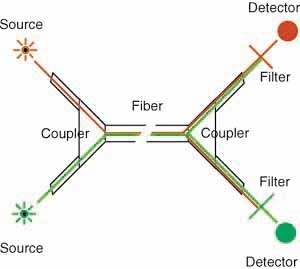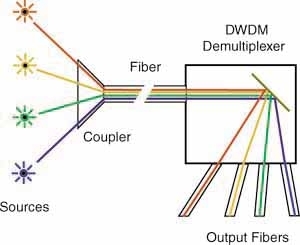- Related articles
- All Cisco SFP-10G-ER's information (List price, Specs, Datasheet PDF, Compatibility matrix
- All Cisco CWDM-SFP-1550's information (List price, Specs, Datasheet PDF, Compatibility mat
- Optical Transceivers for Cisco WS-C2960G-48TC-L Switch
- All Cisco DWDM-X2-44.53's information (List price, Specs, Datasheet PDF, Compatibility mat
- Applicable to 1000BASE-ZX Standard Optical Transceiver Models
- Optical Transceivers for Cisco N9K-X9636PQ= Switch
- What Is GYTA33 Optical Fiber Cable?
- All Cisco DS-SFP-FC8G-LW’s Information (Overview, Features, Data Sheet PDF, Price, Specifi
- Optical Transceivers for Cisco WS-C3560V224PSS-RF Switch
- All Cisco SFP-GE-S's information (List price, Specs, Datasheet PDF, Compatibility matrix)

Definition
Wavelength division multiplexing (WDM) is a technology or technique modulating numerous data streams, i.e. optical carrier signals of varying wavelengths (colors) of laser light, onto a single optical fiber. WDM enables bi-directional communication as well as multiplication of signal capacity.Many customers may don’t know the meaning of wave division multiplexing, here is the datails.
- What is the development of WDM?
- Two different versions of WDM
- How Does WDM Work?
- Advantages of WDM
Early fiber-optic transmission systems put information onto strands of glass through simple pulses of light. A light was flashed on and off to represent digital ones and zeros. The actual light could be of almost any wavelength—from roughly 670 nanometers to 1550 nanometers. Wavelength Division Multiplexing, or WDM, is a technique in fiber-optic transmission that uses multiple light wavelengths to send data over the same medium.
During the 1980s, fiber-optic data communications modems used low-cost LEDs to put near-infrared pulses onto low-cost fiber. As the need for information increased, so did the need for bandwidth. Early SONET systems used 1310 nanometer lasers to deliver 155 Mb/s data streams over very long distances.
But this capacity was quickly exhausted. Over time, advances in optoelectronic components allowed the design of systems that simultaneously transmitted multiple wavelengths of light over a single fiber, significantly increasing fiber capacity. Thus, WDM was born. Multiple high-bit-rate data streams of 10 Gb/s, 40 Gb/s, 100 Gb/s, 200 Gb/s and more recently, 400 Gb/s and 800 Gb/s, each carrying distinct throughputs, can be multiplexed over a single fiber.
What is the development of WDM?
Three methods exist for expanding capacity:
Two different versions of WDM
How does WDM work?
WDM with couplers and filters
WDM demultiplexer
It is easy to understand WDM. Consider the fact that you can see many different colors of light - red, green, yellow, blue, etc. all at once. The colors are transmitted through the air together and may mix, but they can be easily separated using a simple device like a prism, just like we separate the "white" light from the sun into a spectrum of colors with the prism.
Advantages of WDM
A WDM system has some features that make them very usable. Each wavelength can be from a normal link, for example a OC-48 link, so you do not obsolete most of your current equipment. You merely need laser transmitters chosen for wavelengths that match the WDM demultiplexer to make sure each channel is properly decoded at the receiving end.
If you use an OC-48 SONET input, you can have 4X2.5 GB/s = 10 GB/s up to 32 X 2.5 GB/s = 80 GB/s. While 32 channels are the maximum today, future enhancements are expected to offer 80-128 channels!And you are not limited to SONET, you can use Gigabit Ethernet for example, or you can mix and match SONET and Gigabit Ethernet or any other digital signals! You can even mix in analog channels like CATV, as is done with BPON FTTH systems.
Two obvious applications are already in use, submarine cables and extending the lifetime of cables where all fibers are being used. For submarine cables, DWDM enhances the capacity without adding fibers, which create larger cables and bulkier and more complicated repeaters. Adding service in areas where cables are now full is another good application.But this technology may also reduce the cost on all land-based long distance communications links and new technology may lead to totally new network architectures.
High Capacity
An important feature of WDM is that it can make full use of the bandwidth resources of optical fibers, increase the data transmission capacity without changing the basic structure of the existing network, and increase the transmission capacity of an optical fiber many times compared with that of a single wavelength. For example, a DWDM system can support up to 192 wavelengths in a pair of optical fibers, and the transmission capacity of each wavelength is as high as 100Gbit/s ~ about 400Gbit/s and one Terabit/s.
Good Compatibility
WDM has good compatibility with different signals. When transmitting signals of different natures such as images, data and voice in the same optical fiber, each wavelength is independent of each other and does not interfere with each other, ensuring the transparency of transmission.
High Network Flexibility, Economy & Reliability
WDM technology allows for easier upgrades by allowing new channels to be connected as needed without disrupting existing traffic service. When upgrading and expanding the network, there is no need to modify the optical cable line, and new services can be opened or superimposed by adding wavelengths, saving a lot of optical fibers and 3R regenerators during long-distance transmission with large capacity, and the transmission cost is significantly reduced.
Wavelength Routing
WDM technology is one of the key technologies to realize all-optical network. In the all-optical network that is expected to be realized in the future, by changing and adjusting the wavelength of the optical signal on the optical path, the up/down and cross-connection of various telecommunication services can be realized.
Please click to check more related concepts:
| Transceivers Package | Type | Application |
| SFP |
DWDM |
SONET |
| SFP+ | ||
| XFP | ||
| QSFP+ | ||
| X2 | ||
| GBIC | ||
| CFP | ||
|
CSFP |
Transceivers – transmitting data as light
Transceivers are wavelength-specific lasers that convert data signals from SAN and IP switches to optical signals that can be transmitted into the fiber. Each data stream is converted into a signal with a light wavelength that is a unique color. Due to the physical properties of light, channels cannot interfere with each other. All WDM wavelengths are therefore independent. Creating virtual fiber channels in this way means that the number of fibers required are reduced by the factor of the wavelengths used. It also allows new channels to be connected as needed, without disrupting the existing traffic services.
Since each channel is transparent to the speed and type of data, any mix of SAN, WAN, voice and video services can be transported simultaneously over a single fiber or fiberpair.
Multiplexers optimizing the use of fiber channels
The WDM multiplexer, sometimes referred to as the passive mux, is the key to optimizing, or maximizing, the use of the fiber. The multiplexer is at the heart of the operation, gathering all the data streams together to be transported simultaneously over a single fiber. At the other end of the fiber the streams are demultiplexed, i.e. separated into different channels again.
Early WDM systems were able to transport two bi-directional channels over a pair of fibers. The technology has evolved rapidly and both the number of channels and the amount of data per channel transported has increased. Today up to 80 channels can be simultaneously transmitted down a fiber at any one time.
Since they’re usually positioned at the end points in a network, multiplexers are often referred to as terminal muxes. When connecting two sites, a multiplexer is positioned at each site, creating a point-to-point connection. In many cases, networks have additional sites where connectivity is required of some form, but not for all types of traffic. Here optical add drop multiplexers (OADMs) are used to extract the desired wavelengths needed for the specific site while bypassing the traffic types not needed. In this way, more versatile ring, distribution and access networks can be built.







































































